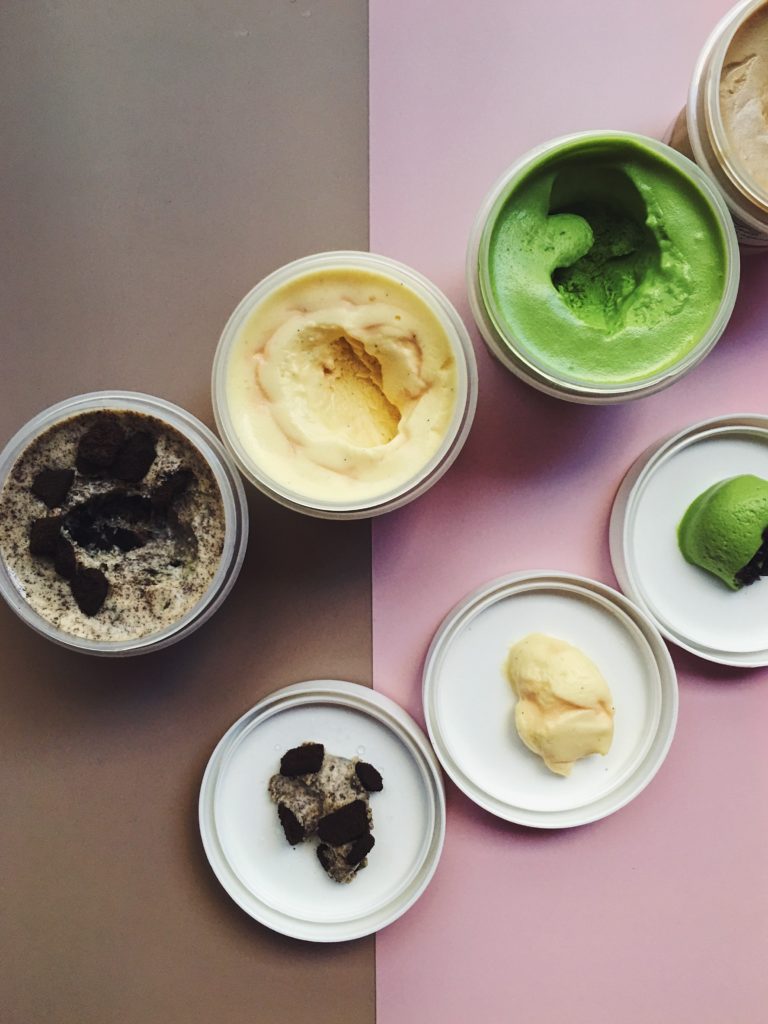It’s a beautiful world when the cure for a belly ache is ice cream. Luckily for us, we might just be living in such a reality. Ice cream producers have been adding gut health enhancing probiotics to everyone’s favorite summertime sweet treat. Think of probiotics and your mind is likely to turn to sour, wintery and fermented foods like sauerkraut and pickled vegetables.
And little wonder. The fermented food and drinks fad has seen kimchi and kombucha make their way into cafe menus all over the globe. With gastroenterologists uncovering the mysteries of the gut in recent years, these bacteria-rich delicacies have become a health trend far beyond the Asiatic regions, where it is believed they originated. It might seem strange then that probiotics, which naturally grow in these warm, fermenting, tangy tasting food and beverages, are being added to our sweet scoops of icy delight. Does this mean probiotic ice cream is just a gimmick to fool the ever increasing cohort of health conscious consumers into thinking an addictive, high sugar treat is actually good for us? Will it rise and fall in culinary popularity like the 1980s prawn cocktail?

Photo: Foxy’s Thoughtful Ice Cream
Angus Murray, founder of Foxy’s Thoughtful Ice Cream, doesn’t think so. He has been adding probiotics to his small batch products for years now. “We were — as far as I am aware — the first company to put probiotics in ice cream, rather than frozen yogurt” which already contains them, he says.
Yogurt, the Indonesian soy product tempeh and Caucasia’s kefir milk, are other examples of fermented foods rich in probiotics — or as Murray likes to call them, “nature’s miracle workers”.
What Are Probiotics?
So what exactly are these wondrous edible things? Put simply, probiotics are living bacteria and yeast we consume for their beneficial qualities. Our bodies are already full of bacteria — they thrive in all sorts of environments including inside our digestive systems. A gut in optimal health is analogous to the complex ecosystem of a rainforest with flora and fauna all interacting in symbiosis. The difference is, your gut ecosystem or ‘microbiome’ is made up of trillions of minuscule microorganisms, mainly single cell bacteria, which are neither plant nor animal. They are so small there are at least a billion of them in every serve of Foxy’s Thoughtful Ice Cream. Some bacteria will make you sick (this is what you would take antibiotics for) but, as Murray says, probiotics are “stealthy healthy stuff”. “I have long taken probiotics as a supplement in my diet, and am fascinated by the biology of gut health.”

Good for Your Belly, Good for Your Brain
What is perhaps most fascinating about gut health are its links to mood and cognitive ability. The relationship between gastroenterology and neurology is a fairly recent discovery. According to Harvard Medical School, “The gut and brain are connected, a partnership called the gut-brain axis.” The two communicate by sending signals and information to each other through the longest nerve in the body, the vagus nerve. And a diet that includes probiotics seems to assist in the maintenance of both a healthy belly and brain. A 2016 study on Alzheimer’s patients found those who drank probiotic milk had higher cognitive functions than those who did not. A 2013 study that compared women who ate probiotic yogurt daily with those who didn’t, found the probiotic consumers were less stressed when shown images of faces in anguish and less likely to experience those distressing fight or flight feelings that literally emanate from the gut. There are even promising studies suggesting probiotics have the potential to positively affect the lives of children living with autism.
In addition to increasing mood and cognitive function, probiotics are believed to help with a myriad of digestive disorders. They are recommended for people taking antibiotics, which kill the good bacteria living in your gut alongside the infectious bacteria they were prescribed to treat. They are also thought to reduce the effects of lactose intolerance, irritable bowel syndrome and — yucky word alert — diarrhoea. In other words, probiotics could help with both common and fairly serious gastroenterological issues. This is great news for kids around the world who can convincingly argue to their parents that ice cream is the antidote for an upset stomach.

Photo: Foxy’s Thoughtful Ice Cream
Add Probiotics to Ice Cream
Despite adding probiotics to their products, Foxy’s holds no pretences over how people relate to ice cream. “We didn’t want to create a ‘healthy’ product,” explained Murray. “Ice cream is about indulgence, about a reward or a treat for yourself.” Or as their website states, ice cream is “something luxurious that scratches an itch in the evening or guarantees the kids will tidy their rooms.”
This philosophy that “ice cream is not supposed to be healthy” sees Foxy’s bucking the trend of reducing the fat content in their products like many major brands have been doing. Instead, they are focused on creating a full taste, premium product that does not shy away from being something to indulge in. They use double cream and natural ingredients (rather than flavors or artificial colors) and they try to source them from smaller, family run producers wherever possible. For their UK made products, the flavor A Rocky Road Less Travelled uses handmade marshmallows from an artisan producer in Murray’s hometown county of Somerset. The milk is from an organic farm about an hour’s drive away in Wiltshire. Their most popular flavor, California Pistachio uses nuts from the United States that Foxy’s dry roasts, salts and chops by hand in the United Kingdom.
The inclusion of probiotics in Foxy’s Thoughtful Ice Cream is what Murray calls “a little something extra”. You might like to think of them as another premium ingredient. Probiotics don’t grow in ice cream like they do in fermenting foods. They need to be put there. But because probiotics are alive, they require more care than ingredients like pistachios and marshmallows. Temperature impacts their stability and lifespan so it’s something Murray has to keep an eye on. “Too hot, and they die. To warm and they could literally start to (spoil) and ferment the food around them.”
“In fact,” Murray said, “Probiotics can handle cold more than they can heat — they are stable and dormant down to very, very low temperatures and come back to life once thawed,” like when you eat and digest them.
Foxy’s adds six different strains of probiotics to the ice cream just before it’s frozen to ensure their viability. “We test the potency of the probiotics before we add them to the ice cream, and then we test again once (they) have frozen and thawed out.” Murray explains they lose about 5% of them during this process, “which is very little when we’re putting (in) over 12 billion per pint (473ml)”.
Production of Foxy’s may sound a touch high tech for ice cream but the flavors are archetypal: Thoughtful Vanilla, Oregon Cherry Vanilla, Uncle Mike’s Double Chocolate, Salted Caramel, and English Toffee. “My inspiration for the flavors is to stick with classics, and make them the best they can be whilst being sensitive to the origin of the ingredients,” said Murray.

Fad or Future?
Foxy’s small batch, classic flavor approach is different to, say, Unilever’s, a major US retailer that is behind the probiotic ice cream label Culture Republik and many other major brands spanning food and beauty like Ben & Jerry’s, Magnum, Lipton, Dove, Rexona, and Vaseline. Their flavors include Matcha & Fudge and Turmeric Chai & Cinnamon which are more avant-garde. And they are available in superstores like KMart.
Does Unilever’s presence in this market signal probiotic ice cream is just another fad for mega brands to exploit before consumers move onto the next big thing? Murray doesn’t think so. “There are so many ‘fad’ and ‘posh’ dietary trends at the moment — some come and go — but I think probiotics are here to stay.”
About Foxy’s Thoughtful Ice Cream
Established by Angus Murray, the brand is believed to be the first ice cream with probiotics added globally. Foxy’s now is available in the United States, the United Kingdom and selected Asian countries and regions.













NO COMMENT